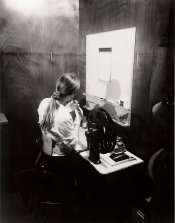For 4x5, Kodak 400TMY2 is my standard, though I have 10 sheets of 100TMX in the freezer that I'll get to at some point for something special if I feel that I want that kind of resolution. For 120, It's either Kodak 400TX or 100TMX, mainly because with my process I develop them both exactly the same way and can shoot either one depending on how much light I have and just throw it all in the tank and go. For 35mm, mostly 400TMY2, though again, I have a few rolls of 100TMX in the freezer that I'll get to at some point. 35mm is my little "point and shoot" (Fujifilm Klasse) that I either always have in my pocket, or in my bag, so I can just grab it and catch snaps of the kids and stuff. I'd shoot 400TX, but for 35mm, it's a bit too grainy for my tastes, so it's TMY2. A lot less grain, and good resolution for 35mm. 120 is a couple of different cameras, my preferred is the Fuji GW690 for shooting 6x9. Big honking negative in roll film form. The lens on the camera is ridiculously sharp, and on a negative that size, 400TX grain is about the same as 400TMY2 grain in 35mm form, which I'm fine with. With 100TMX, man, 120 6x9 is *a lot* of resolution. I've yet to have a situation where I had visible grain on those negatives. It's awesome. For 4x5, I have two systems. One is a Toyo field camera, the other a studio monorail that is more custom parts than anything else. Again, 400TMY2 is my standard just because I can very easily use it out in the field, and for studio work, it lets me stop down a couple of stops to get a little more DOF if I need it, and 400TMY2 is fine grained enough that in 4x5, grain is pretty much a non-issue.
I'm a hybrid, so nowadays for simplicity and productivity, I've pretty much standardized on D-76 1:1 at 68 degrees. 400TMY2 is 10:00, and 100TMX and 400TX are 9:30. I do one gentle inversion every 15 seconds with a tap on the counter for everything (including fixer). From there, it's a standardized raw scan that is then fed into a lut tool that inverts the image and converts it to 32 bit floating point linear light space in a tiff file (with a linear icc profile attached). The lut (look up table) tool acts as a film profile that contains density readings of the film in full stop increments from film fog to max density. As long as I develop and scan exactly the same way every time, I get a nice floating point tiff file that can have upwards of 15+ stops of light in it (depending on scene shot and film used) that I just pull into Adobe Lightroom and treat just like I would any other raw image from any other source. It's great and super consistent and lets me use all the other same post processing tools that I use for digital shooting, and most importantly, it lets me be pretty productive, but still shoot film which gives me a physical archive of what I've shot, which is what I want.
I've been considering moving all the development to 9:30 so it's all exactly the same, but that would mean I'd probably dump a good stop of light right into the film base for 400TMY2 (not decided yet if I want to do that), and I'd have to re-profile the film make a new 400TMY2 lut, but if I go that route, I can shoot as I please and just throw it all in the same big tank (for roll film at least).











